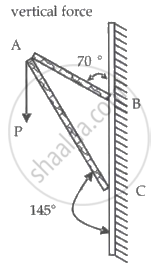Advertisements
Advertisements
प्रश्न
According to the third law of motion, action and reaction :
विकल्प
always act on the same body but in opposite directions
always act on different bodies in opposite directions
have same magnitudes and directions
act on either body at normal to each other
उत्तर
always act on different bodies in opposite directions.
APPEARS IN
संबंधित प्रश्न
If action is always equal to the reaction, explain how a horse can pull a cart.
Explain, why is it difficult for a fireman to hold a hose, which ejects large amounts of water at a high velocity.
A stone of 1 kg is thrown with a velocity of 20 m s−1 across the frozen surface of a lake and comes to rest after travelling a distance of 50 m. What is the force of friction between the stone and the ice?
Using a horizontal force of 200 N, we intend to move a wooden cabinet across a floor at a constant velocity. What is the friction force that will be exerted on the cabinet?
What is the force which produces an acceleration of 1 m /s2 in a body of mass 1 kg ?
A girl weighing 25 kg stands on the tloor. She exerts a downward force of 250 N on the floor. What force does the floor exert on her ?
Do action and reaction act on the same body or different bodies ? How are they related in magnitude and direction ? Are they simultaneous or not ?
Draw a diagram to show how a rocket engine provides a force to move the rocket upwards. Label the diagram appropriately.
According to the third law of motion, action and reaction
Consider a frame that is made up of two thin massless rods AB and AC as shown in the figure. A vertical force `vec"P"` of magnitude 100 N is applied at point A of the frame.

Suppose the force is `vec"P"` resolved parallel to the arms AB and AC of the frame.
The magnitude of the resolved component along the arm AC is xN.
The value of x, to the nearest integer, is ______.
[Given: sin(35°) = 0.573, cos(35°) = 0.819, sin(110°) = 0.939, cos(110°) = –0.342]
